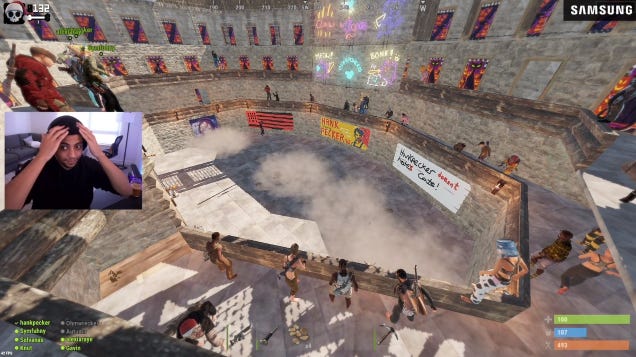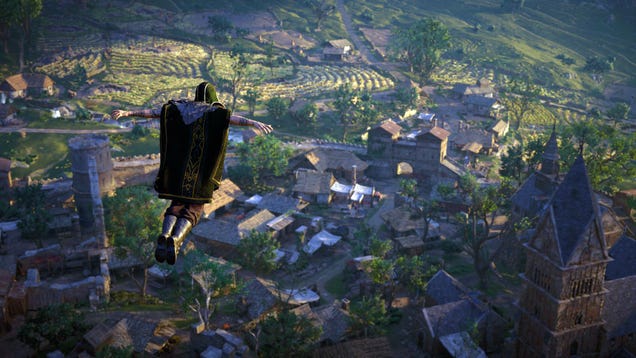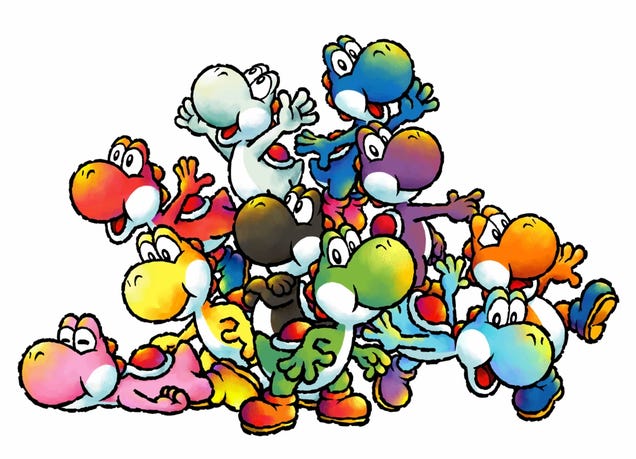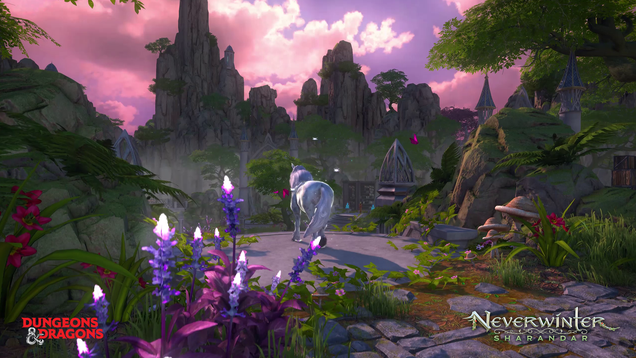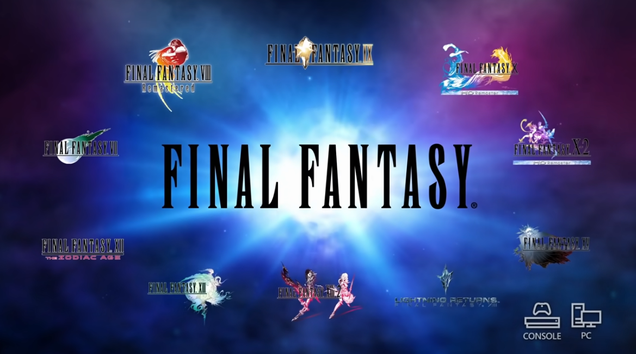There is no predicting which game Twitch will catapult into the spotlight next. Last year, it was Among Us, a previously obscure party game about deception. Now, it’s Rust, a survival game that first came out in 2013, whose heyday was thought to have long since passed. These seemingly random flavors of the month have a major thing in common: The creation of the streamer cinematic universe.
Streamer collaborations are nothing new, but Rust and Among Us have thrived because they’ve managed to span not just multiple streamers, but multiple streamer cliques. However, while Among Us games are still relatively self-contained, the larger Rust story revolves around popular streamers piled onto a handful of creator-exclusive servers that continue to exist whether streamers are logged on or not. The exclusivity eliminates problems like stream sniping—where fans show up and try to kill or annoy select streamers—which plagued earlier iterations of Rust’s streaming scene, while creating an easy to follow set of characters.
OfflineTV, a streamer collective that includes stars like Imane “Pokimane” Anys, Jeremy “Disguised Toast” Wang, and Lily “LilyPichu” Ki, is generally credited with having kicked off the new trend, with a server that began late last year as a sort of large-scale social experiment, only to (temporarily) collapse under the interlocking weights of lawlessness and drama. Earlier this month, OfflineTV split its operation into two servers, one more focused on PVP and another built for role-playing (and light, character-driven PVP), where big names without esports-level PVP experience have mostly coalesced.
Make no mistake: Rust would not have blown up the way it has if not for the first OfflineTV server’s December chaos. Rust is a game in which it feels like anything can happen. Players start out literally naked and likely afraid, at which point they must collect resources in order to craft weapons, clothing, and eventually, elaborate bases. On a regular Rust server, it’s hard to know where you stand with other players, and you never know when a rando might snipe your head off. That, however, does not always make for compelling viewing, so many streamers on the original OfflineTV server focused more on role-playing, collaboration, base building, and (mostly) lighthearted rivalries between groups.
The first OfflineTV server was fun to watch because dozens of top streamers were all living in the same bubble, bumbling through a long-running but also comically janky game that none of them had mastered. Even during less action-packed moments of crafting and building, Rust excels at the kind of wordless, deranged glitch comedy that only video games can produce. For example, here’s popular streamers Sykkuno and Mendo losing their shit after another streamer dodged a spear and then immediately impaled themselves on a spiked wooden barricade, which caused them to collapse like a bundle of rope.
It’s hard to explain in words exactly why it’s so funny. You just need to watch it. Rust is full of moments like that. You never know when the game itself might lash out and exact random slapstick vengeance against those who dare to play it. Or when everybody might explode.
But a large part of Rust’s streaming appeal comes, predictably, from the streamers themselves. You never knew when an A-lister from one corner of Twitch’s upper echelon might cameo on another’s show. For example, many viewers have seen Michael “Shroud” Grzesiek peek around corners and obliterate opponents with preternatural speed and precision in games like Counter-Strike and Valorant, but it hits different when those opponents are other streamers who’ve haphazardly taken over a player-made police station, and Grzesiek has been called in to save the day by overwhelming an entire squad with his otherworldly skill. Streamers aren’t just good gamers anymore. They’re characters playing out an unwritten story.
Again, it feels like anything can happen. But in order for that to truly be the case, you need players who are willing to go against the grain—to prove that anything can happen. That ended up being both the appeal and downfall of the first version of OfflineTV’s Rust server.
The spark that lit the powder keg was eternally divisive Twitch megastar Félix “xQc” Lengyel. Lengyel started shit with everybody, often in the form of PVP conflicts where he had the upper hand as a former professional Overwatch player. He formed an in-game group called Team Rocket around this. His hyper-competitive approach included raids on other players’ compounds and accusations that other big names, like former Fortnite pro Ali “Myth” Kabbani, were cheating, and it quickly led others like Anys and Chance “Sodapoppin” Morris to consider quitting Rust altogether.
Lengyel was also an ideal villain not just in the sense that he was doing things other streamers didn’t like, but because his online presence has never been polished or calculated. Instead, he’s prone to emotional outbursts and indulging his id. That carried over to the first OfflineTV Rust server in the form of plans that often went comically awry. There is an undeniable appeal, for instance, to hearing that big bad boogeyman Lengyel is on the way to murder Anys, only for him to charge onto the scene atop a glorious steed, dismount, and immediately get shot in the face by Anys. Then there’s this absolutely classic moment where Lengyel and his Team Rocket compatriots tried to storm a boat by dropping in from a military chopper, only to... miss the boat.
Lengyel was a uniquely comical villain, the sort that a game as inherently goofy as Rust deserves. And he fit Twitch like a glove: effective, but also messy and unpredictable—difficult to look away from. The drama he stirred up brought viewers to the OfflineTV server in droves, but there was one problem: Many of the other streamers were not having any fun. It’s a duality we’ve seen in other games like Sea of Thieveswhen veteran streamer Jared “Summit1g” Lazar terrorized the high seas in 2018 and 2019. In that instance too, the PVP was fun to watch, but the waters soon turned choppy and toxic. On the first OfflineTV Rust server, Lengyel’s audience also got involved, sending harassing messages to another streamer, Ash On LoL, after the two got into an argument in-game (Lengyel ultimately apologized for his behavior).
So after a brief hiatus, a second OfflineTV server, “The Divide,” was born last week. It did not take long for most of Twitch’s biggest personalities to migrate over. This has allowed role-play to thrive with popular streamers embracing personas adjacent to their own,but different enough to be interesting. Leftist political streamer Hasan Piker, for example, plays a southern-accented right-winger named Hank Pecker. While decorating his first fort, he drew a hammer and sickle. Then he wrote “QAnon” next to it. Now, he’s disputing the results of an in-game mayoral election he lost, because of course. Meanwhile, Anys is French, and Morris leads a collective of cat people who say “meow” at the end of every other sentence and run a PVP arena. The server also includes experienced role-players like Vader, who made his name in the Grand Theft Auto role-playing scene. Then there are streamers playing more functional roles, like journalists and police.
It still feels like anything can happen, but in a more tamped down way. Nobody gets randomly killed anymore, but there are still moments of pleasant pandemonium. Yesterday, I tuned into Kabbani’s stream to find him role-playing a new character who’s a regular dude by day and a screaming, Gollum-voiced cannibal by night. Kabbani has fully committed to the bit, with blood-curdling shrieks a plenty. As his chat will tell you (over and over), his persona toes the line between convincing and cringe. A lot of Rust role-playing is like that. Either way, it’s impossible to look away, especially when he’s lunging at other players with a bone knife—even if he’s not allowed to actually kill them outside specifically sanctioned PVP areas.
The end result is a fascinating brand of collaborative storytelling. Even when nobody’s shooting, it remains chaotic, with players talking over each other and fighting for the spotlight. But when everything clicks, the results range from uproariously funny to surprisingly moving. You never know entirely what you’re going to get, but the cumulative result is a new spin on online storytelling that builds on itself over time. A meme might be born one day, and then a week later, it’s lore—backstory that informs a storyline or a new character.
This kind of long-term crossover appeal is very evidently an emerging trend on Twitch. Another breakout hit of the past handful of months, the “Dream SMP” Minecraft server, is driven by collaboration between popular Minecraft streamers who mix impromptu role-playing with pre-written, lore-packed story arcs. Dream SMP streamers like the UK-based TommyInnit, unsurprisingly, have also recently dipped their toes into Rust. So have enormously popular Spanish streamers like Rubius, Auronplay, and TheGrefg (who now holds Twitch’s all-time viewership record).
Everybody is playing Rust right now. As a result, the game’s total concurrent viewer count on Twitch has crossed the one million mark multiple times in the past couple weeks. This makes sense in the era of covid: There is a vicarious appeal to watching a bunch of people who feel like your friends hang out day-in and day-out, even if it’s in a virtual environment. OfflineTV’s Rust servers also allow streamers across Twitch, YouTube, and Facebook to peacefully (or sometimes, not-so-peacefully) coexist. It is, in multiple ways, an ideal game for the current moment, despite first coming out more than seven years ago.
Though blindsided at first, Rust’s developer, Facepunch Studios, has certainly taken notice, given that Rust is now having a renaissance on both Twitch and Steam. Despite speculation to the contrary, the company did not pay streamers to play its game.
“It was a surprise,” said Facepunch founder Garry Newman in a DM to Kotaku. “We’ve worked to make Rust more streamable, but it’s still really not that streamable in its vanilla form. The OTV server definitely kicked it off, they did it all by themselves.” Facepunch did, however, capitalize on Rust’s Twitch comeback by adding limited-time drops—in-game items players can earn by watching streamers play—themed after specific streamers like Grzesiek, Lengyel, and Anys.
“We set it up after [Rust blew up on Twitch],” said Newman. “We had a Twitch drop event coming up anyway, so we decided to give those guys their own skins to make it more interesting.”
Newman said streamers are not directly making money off those items, but over the past couple years, drops have become the Twitch meta. Players flock to corresponding streamers’ channels, boosting their numbers significantly. As of today, however, the drop event just wrapped up. Will the stories that streamers craft be enough to stop viewer counts from dropping too? That’s the question.
As of this publishing, Rust is still near the top of Twitch. Like every other Twitch trend, it will eventually run its course. No matter what happens next, though, the relatively ancient survival game has given us a glimpse of Twitch’s future: an interconnected, overlapping streamer universe where you never know who will show up next—or what hammy accent they’ll have.
Fonte: kotaku


